Our recent news
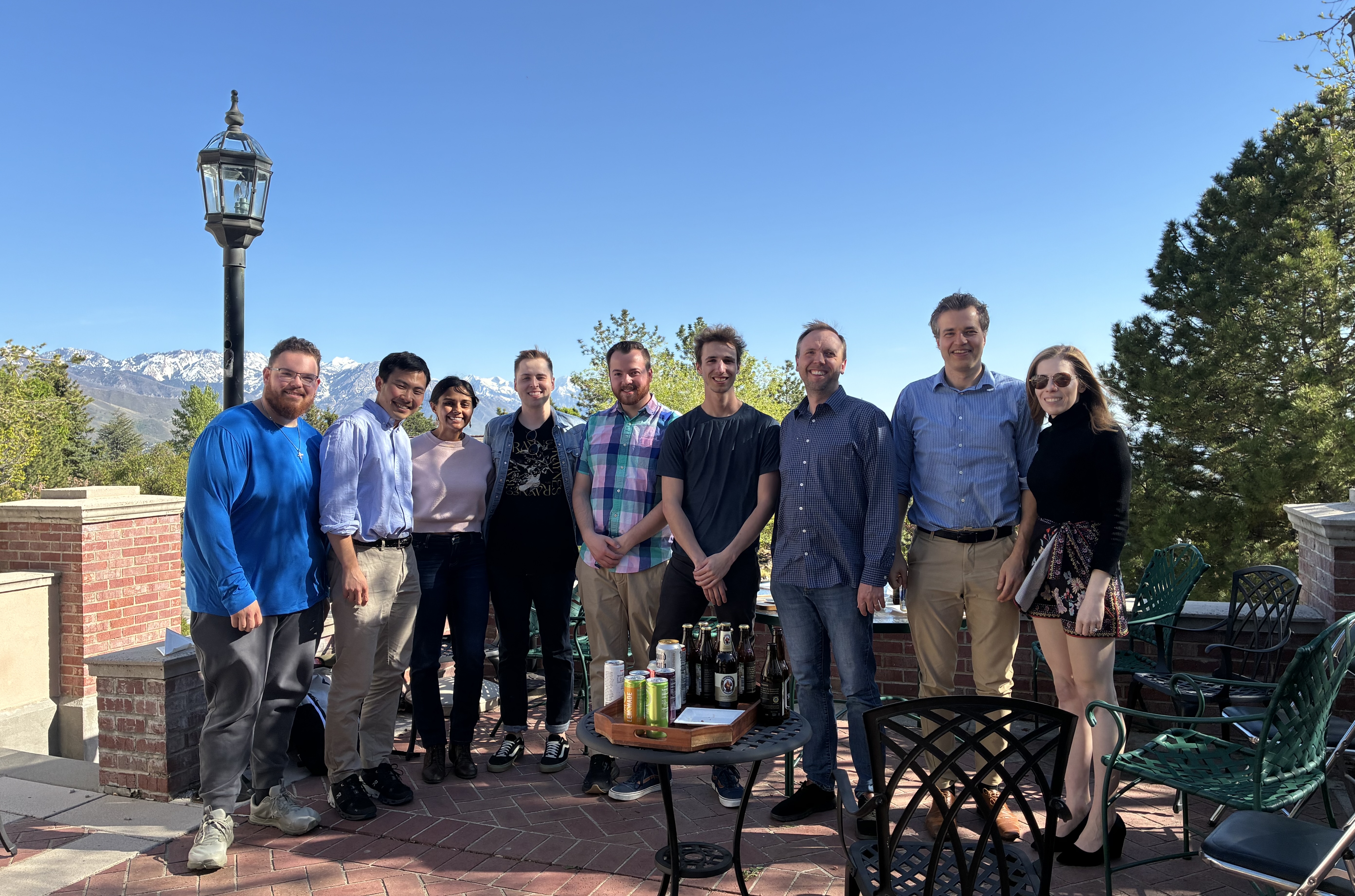 Annual lab party
An all-star team all in one place.
May 2, 2025
Annual lab party
An all-star team all in one place.
May 2, 2025
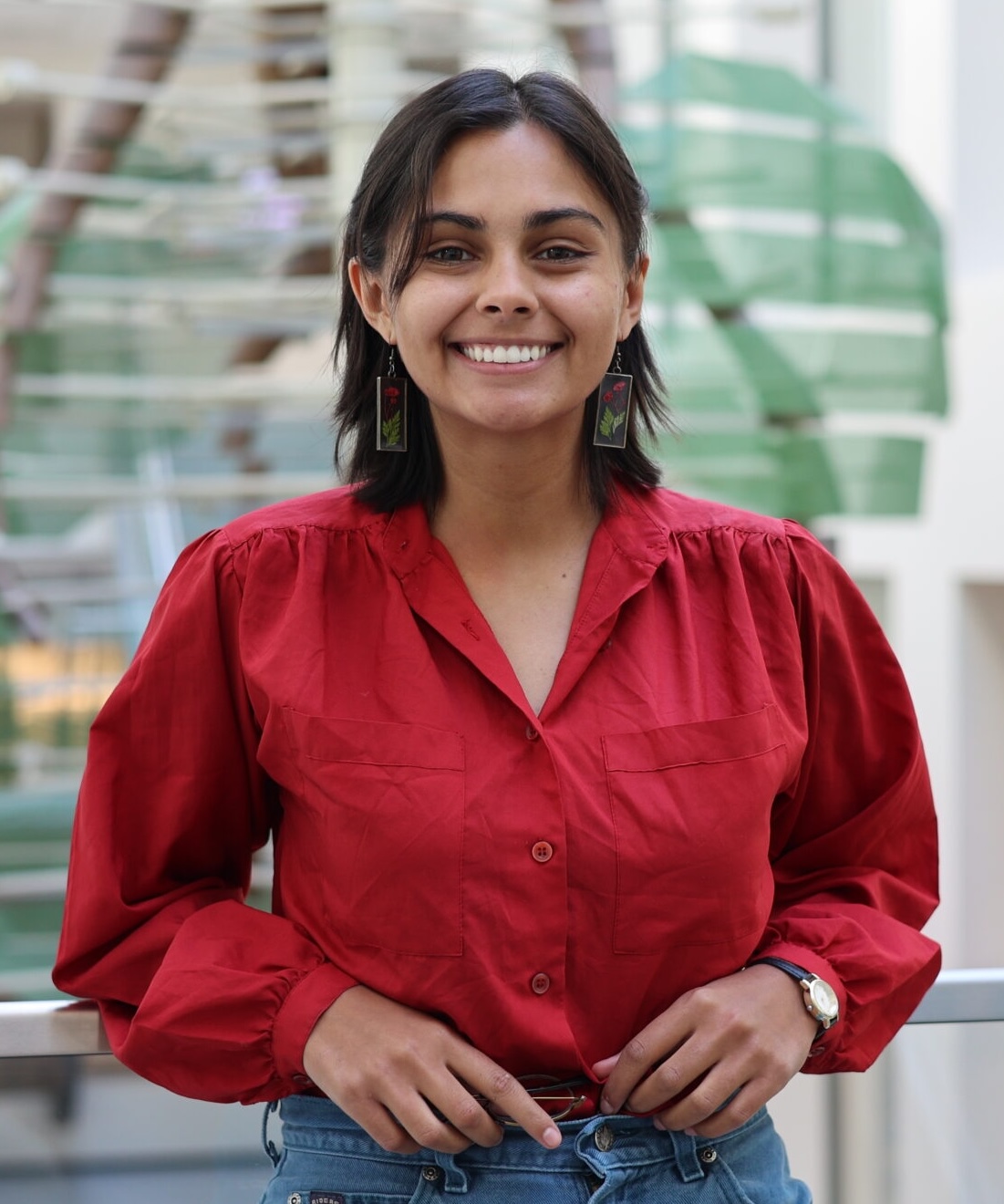 Audri Dara defended her MS thesis
Audri has developed an approach to release drugs in brain tumors at high concentration. The approach is based on ultrasound-sensitive nanoparticle carriers.
March 14, 2025
Audri Dara defended her MS thesis
Audri has developed an approach to release drugs in brain tumors at high concentration. The approach is based on ultrasound-sensitive nanoparticle carriers.
March 14, 2025
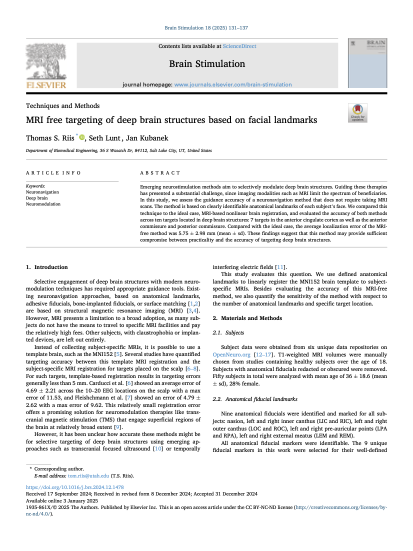 Article on MRI-free targeting published
This article demonstrates deep brain targeting based on anatomical landmarks of the head.
January 12, 2025
Article on MRI-free targeting published
This article demonstrates deep brain targeting based on anatomical landmarks of the head.
January 12, 2025
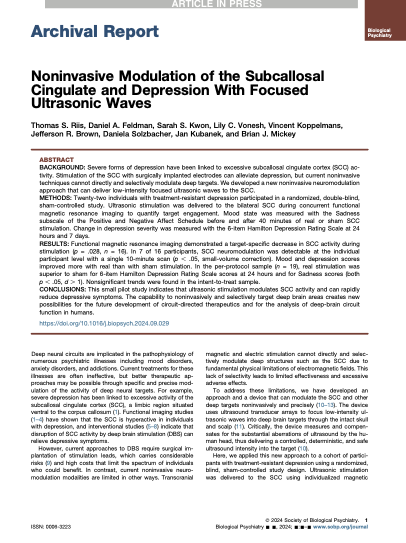 Article on treatments of depression published
This article shows that Diadem applied to the subcallosal cingulate cortex provides a rapid and sustained improvement in depressive symptoms.
October 18, 2024
Article on treatments of depression published
This article shows that Diadem applied to the subcallosal cingulate cortex provides a rapid and sustained improvement in depressive symptoms.
October 18, 2024
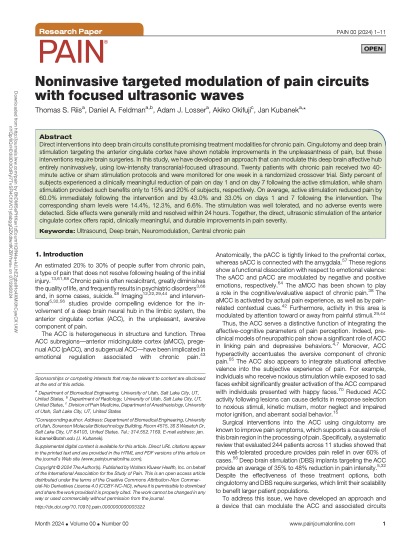 Article on treatments of chronic pain published
This article shows that Diadem applied to the cingulate cortex provides a rapid and sustained improvement in pain intensity.
August 1, 2024
Article on treatments of chronic pain published
This article shows that Diadem applied to the cingulate cortex provides a rapid and sustained improvement in pain intensity.
August 1, 2024
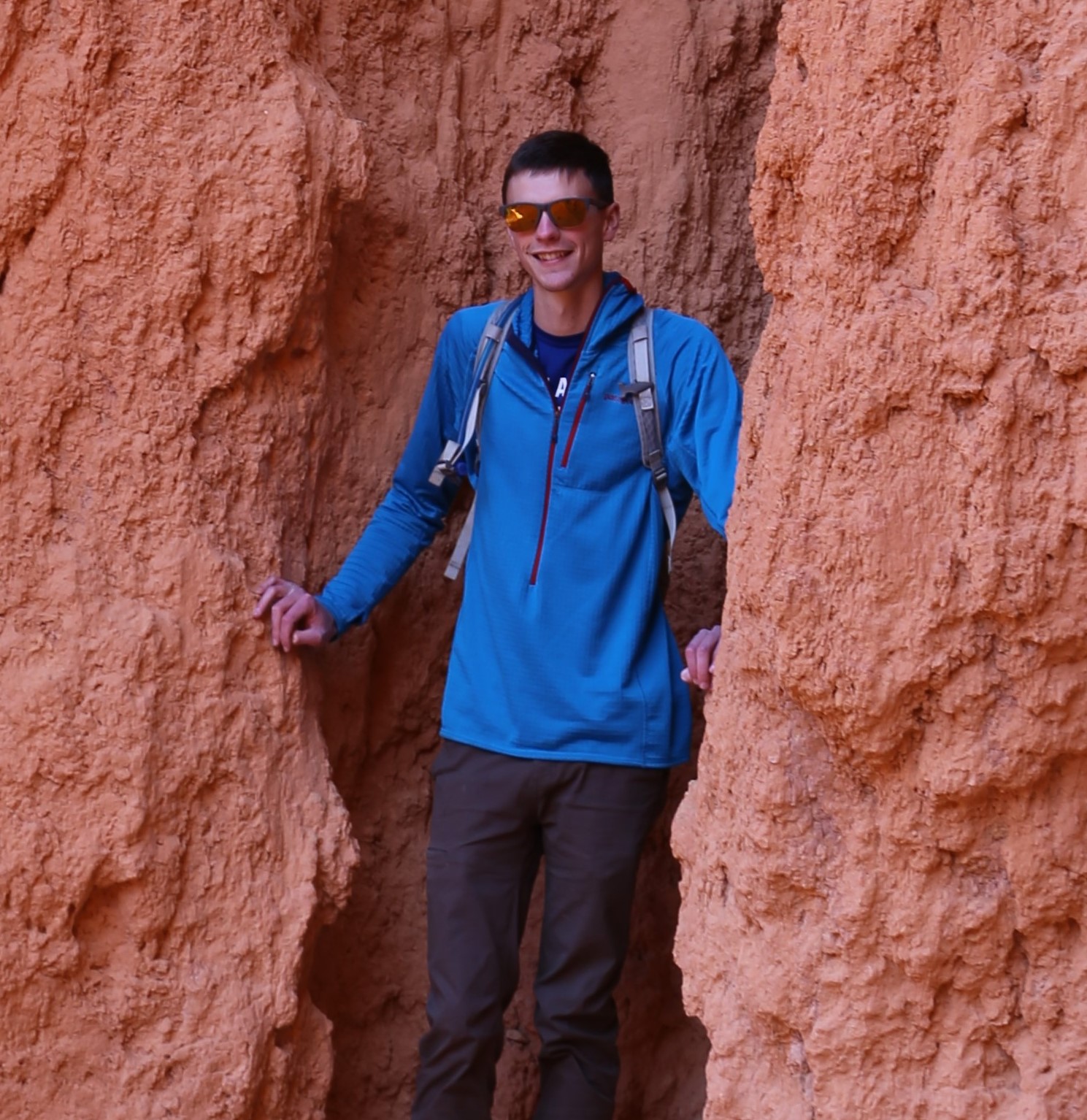 Matt Wilson defended his PhD thesis
Matt has developed and validated a new method for local drug release in non-human primates and defended his PhD thesis. Congratulations, Matt!
June 14, 2024
Matt Wilson defended his PhD thesis
Matt has developed and validated a new method for local drug release in non-human primates and defended his PhD thesis. Congratulations, Matt!
June 14, 2024
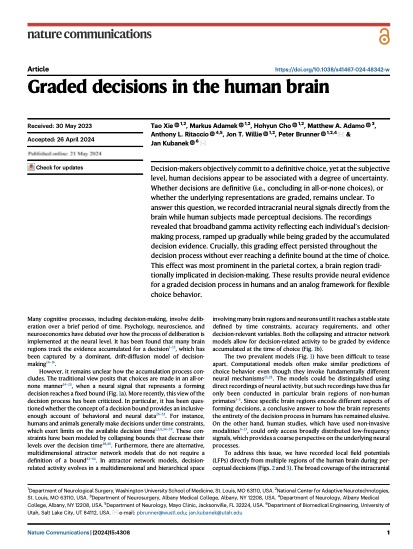 Article on neural correlates of decision-making in humans published
This article shows that decisions may be graded instead of a binary, all-or-none nature. Recordings directly from the human brain show that the neural signals underlying decisions reflect varying levels of the decision-maker's confidence.
May 13, 2024
Article on neural correlates of decision-making in humans published
This article shows that decisions may be graded instead of a binary, all-or-none nature. Recordings directly from the human brain show that the neural signals underlying decisions reflect varying levels of the decision-maker's confidence.
May 13, 2024
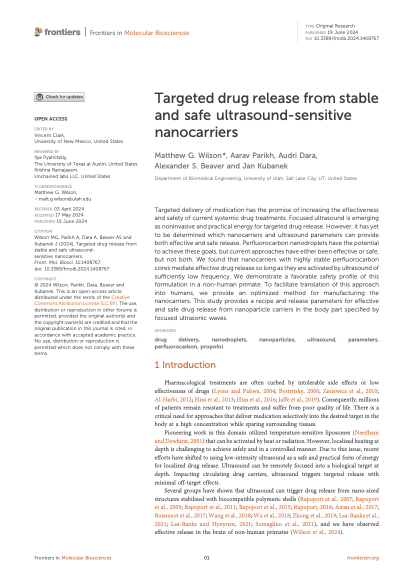 Article on drug release optimization published
This article shows how to maximize the effectiveness of drug release from ultrasound-sensitive nanoparticle carriers.
March 15, 2024
Article on drug release optimization published
This article shows how to maximize the effectiveness of drug release from ultrasound-sensitive nanoparticle carriers.
March 15, 2024
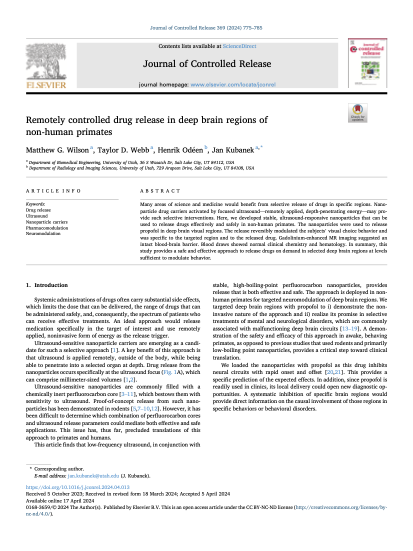 Article on drug release from nanoparticle carriers published
This article shows that it is possible to use use ultrasound to effectively and safely release a drug from nanoparticle carriers in deep brain regions in non-human primates, and thus modulate choice behavior.
March 9, 2024
Article on drug release from nanoparticle carriers published
This article shows that it is possible to use use ultrasound to effectively and safely release a drug from nanoparticle carriers in deep brain regions in non-human primates, and thus modulate choice behavior.
March 9, 2024
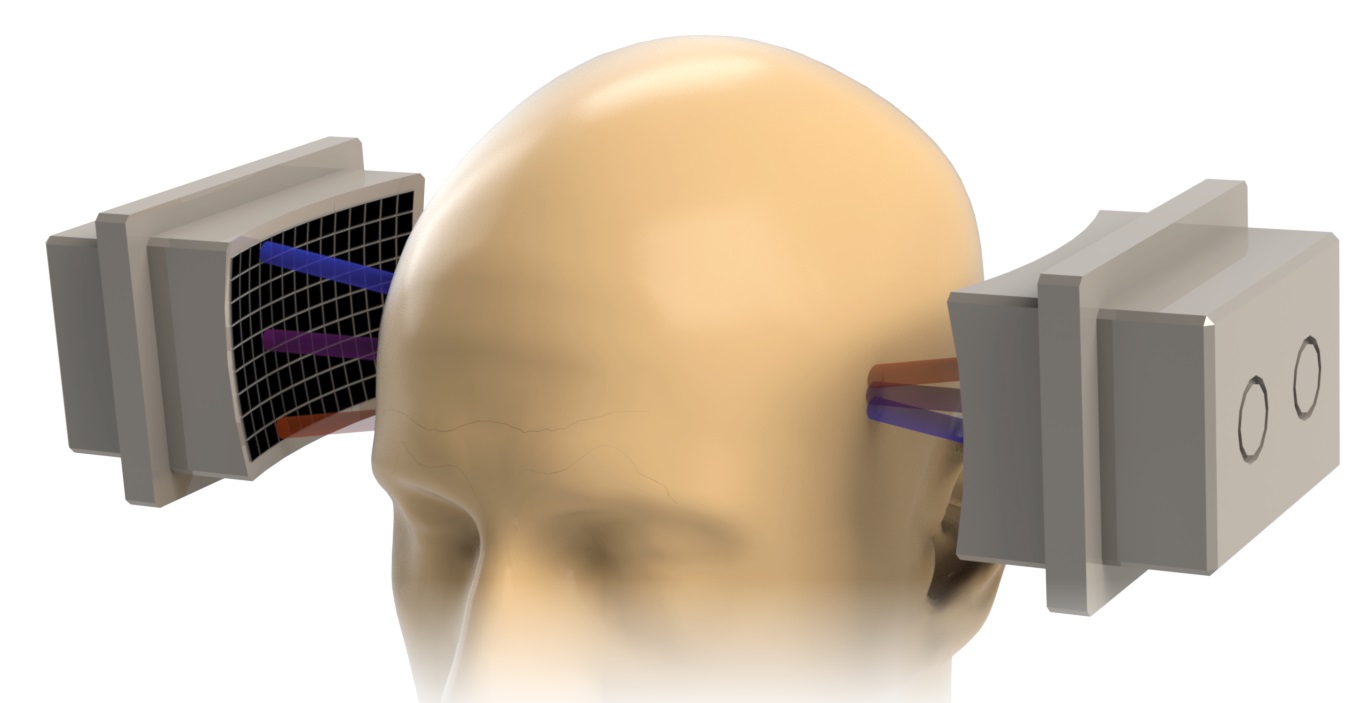 Article featured on journal cover page
This article was featured on the cover of Transactions on Biomedical Engineering. The cover is also available at https://www.embs.org/tbme/articles/device-for-multifocal-delivery-of-ultrasound-into-deep-brain-regions-in-humans.
February 11, 2024
Article featured on journal cover page
This article was featured on the cover of Transactions on Biomedical Engineering. The cover is also available at https://www.embs.org/tbme/articles/device-for-multifocal-delivery-of-ultrasound-into-deep-brain-regions-in-humans.
February 11, 2024
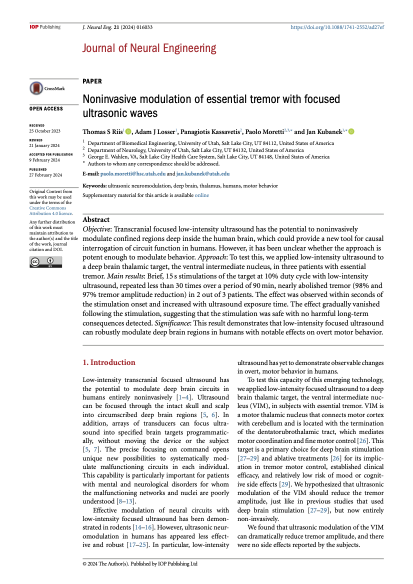 Featured article
This article was selected as a featured article by IEEE.
February 10, 2024
Featured article
This article was selected as a featured article by IEEE.
February 10, 2024
 Article on direct modulation of tremor published
This article shows that Diadem can be used to noninvasively modulate deep brain circuits involved in tremor and directly modulate tremor behavior.
February 9, 2024
Article on direct modulation of tremor published
This article shows that Diadem can be used to noninvasively modulate deep brain circuits involved in tremor and directly modulate tremor behavior.
February 9, 2024
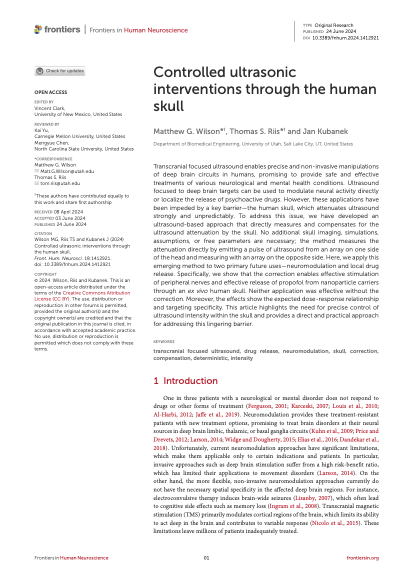 Article on Diadem's correction for the head published
This article shows that Diadem's correction for the head is critical for effective neuromodulation.
February 4, 2024
Article on Diadem's correction for the head published
This article shows that Diadem's correction for the head is critical for effective neuromodulation.
February 4, 2024
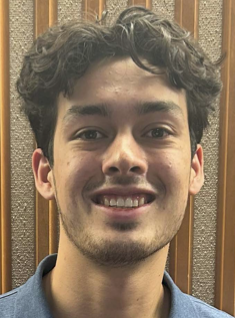 Jude Werth receives the UROP fellowship
Jude develops an approach to record neural activity of human brain organoids. Congratulations, Jude!
January 10, 2024
Jude Werth receives the UROP fellowship
Jude develops an approach to record neural activity of human brain organoids. Congratulations, Jude!
January 10, 2024
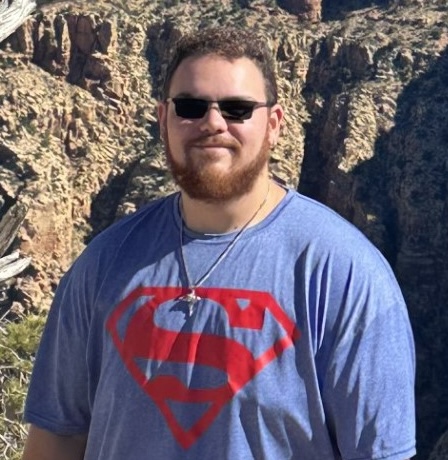 Joshua Whiting joins the lab
Josh is optimizing a new approach that releases drug locally. Welcome, Josh!
January 5, 2024
Joshua Whiting joins the lab
Josh is optimizing a new approach that releases drug locally. Welcome, Josh!
January 5, 2024
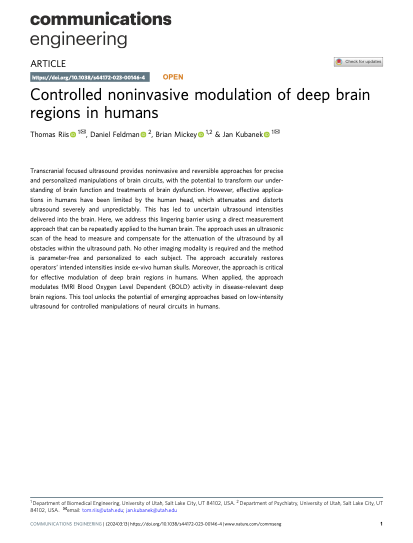 Article on practical correction for the ultrasound distortions by the human head published
This article demonstrates a new, direct way to measure and compensate for the severe distortion of ultrasound by the human head and hair.
December 27, 2023
Article on practical correction for the ultrasound distortions by the human head published
This article demonstrates a new, direct way to measure and compensate for the severe distortion of ultrasound by the human head and hair.
December 27, 2023
 Jude Werth joins the lab
Jude will develop an approach to record neural activity from many brain organoids simultaneously and continuously. Welcome, Jude!
December 5, 2023
Jude Werth joins the lab
Jude will develop an approach to record neural activity from many brain organoids simultaneously and continuously. Welcome, Jude!
December 5, 2023
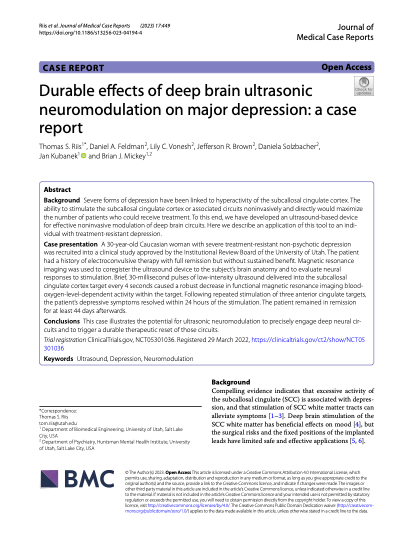 Diadem provides strong and durable improvement in major depression
This article reports the use of Diadem in a first patient with major depression. Ultrasonic modulation of the subgenual cingulate robustly engaged the target, based on fMRI, and provided a rapid and sustained relief.
October 28, 2023
Diadem provides strong and durable improvement in major depression
This article reports the use of Diadem in a first patient with major depression. Ultrasonic modulation of the subgenual cingulate robustly engaged the target, based on fMRI, and provided a rapid and sustained relief.
October 28, 2023
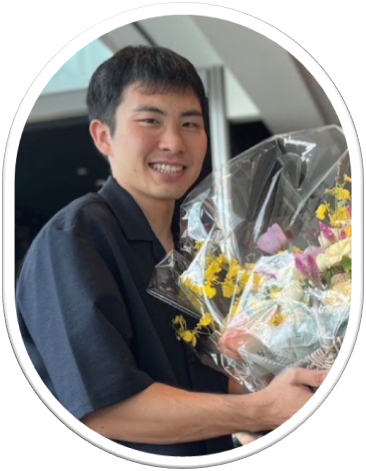 Keisuke Tsunoda joins the lab
Keisuke will develop and apply new approaches for noninvasive targeted brain stimulation. Welcome, Keisuke!
October 1, 2023
Keisuke Tsunoda joins the lab
Keisuke will develop and apply new approaches for noninvasive targeted brain stimulation. Welcome, Keisuke!
October 1, 2023
 Audri Dara joins the lab
Audri is developing a new approach that releases drug locally. Welcome, Audri!
August 12, 2023
Audri Dara joins the lab
Audri is developing a new approach that releases drug locally. Welcome, Audri!
August 12, 2023
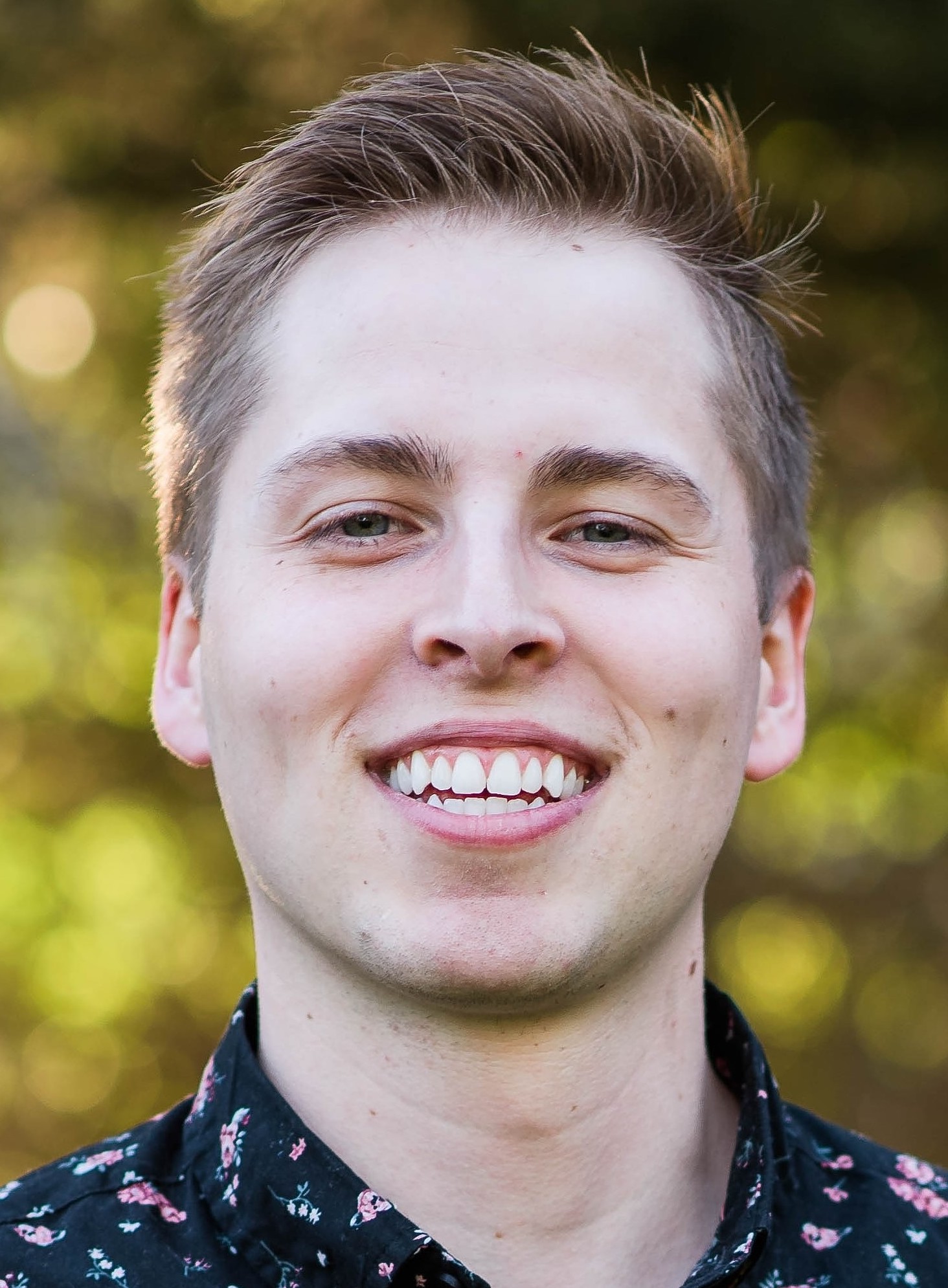 Carter Lybbert joins the lab
Carter has joined the lab to modulate coma states and other disorders of brain function. Welcome, Carter!
July 20, 2023
Carter Lybbert joins the lab
Carter has joined the lab to modulate coma states and other disorders of brain function. Welcome, Carter!
July 20, 2023
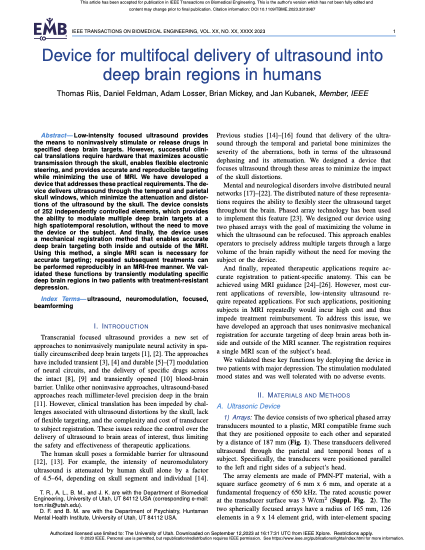 Device for multifocal delivery of ultrasound into
deep brain regions in humans
This published article develops a device, Diadem, for noninvasive deep brain stimulation in humans. Diadem is being deployed in clinical studies targeting major depression and centralized chronic pain.
June 15, 2023
Device for multifocal delivery of ultrasound into
deep brain regions in humans
This published article develops a device, Diadem, for noninvasive deep brain stimulation in humans. Diadem is being deployed in clinical studies targeting major depression and centralized chronic pain.
June 15, 2023
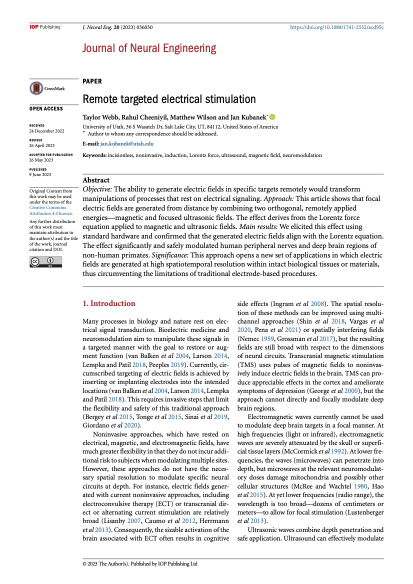 Article published in the Journal of Neural Engineering
This article shows that focal electric fields can be generated remotely by combining focused ultrasonic and magnetic fields.
June 5, 2023
Article published in the Journal of Neural Engineering
This article shows that focal electric fields can be generated remotely by combining focused ultrasonic and magnetic fields.
June 5, 2023
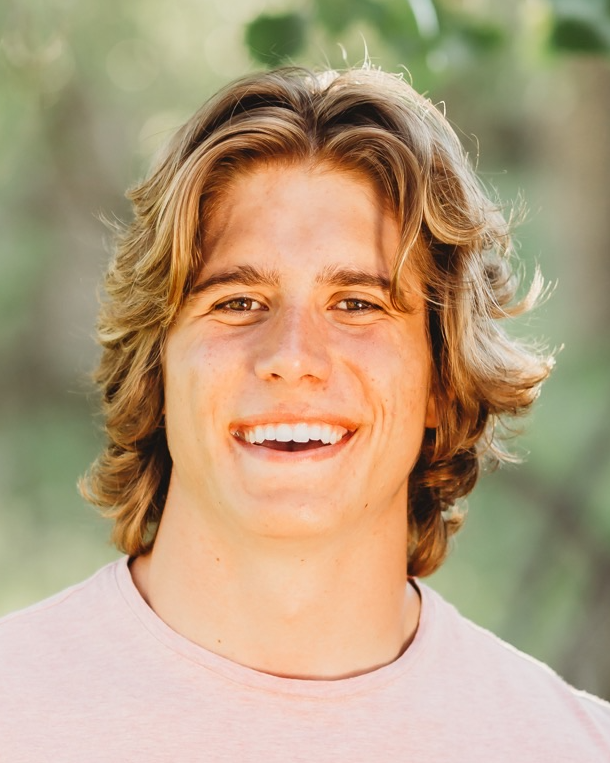 Luke Loehding receives the UROP fellowship
Luke is developing a noninvasive approach to modulate chronic pain. Congratulations, Luke!
May 30, 2023
Luke Loehding receives the UROP fellowship
Luke is developing a noninvasive approach to modulate chronic pain. Congratulations, Luke!
May 30, 2023
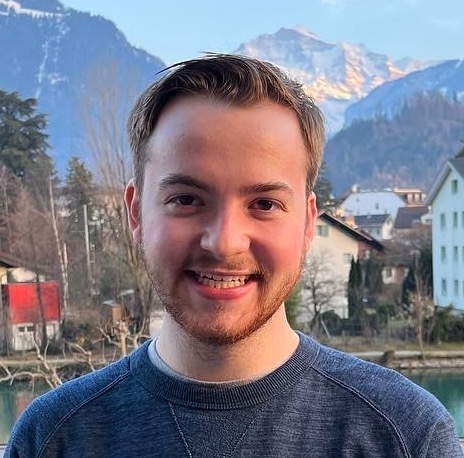 Adam Losser joins the lab
Adam is joining the lab as a key technician and clinical coordinator. Welcome, Adam!
May 20, 2023
Adam Losser joins the lab
Adam is joining the lab as a key technician and clinical coordinator. Welcome, Adam!
May 20, 2023
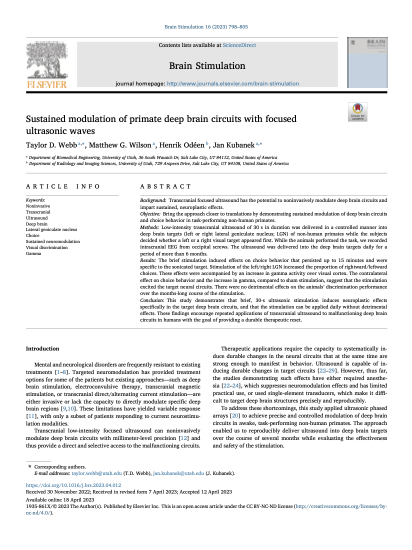 Article published in Brain Stimulation
This paper shows that transcranial ultrasound can induce durable, neuroplastic effects in deep brain regions of task-performing non-human primates.
April 21, 2023
Article published in Brain Stimulation
This paper shows that transcranial ultrasound can induce durable, neuroplastic effects in deep brain regions of task-performing non-human primates.
April 21, 2023
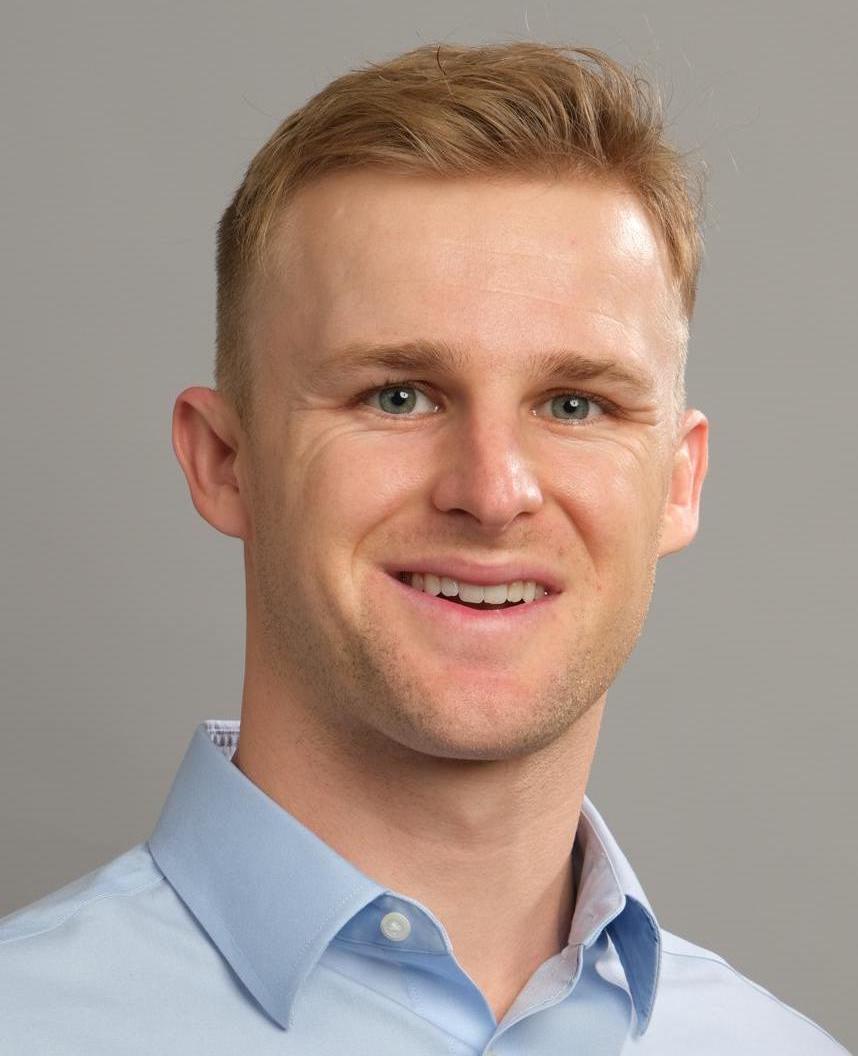 Tom Riis defended his PhD thesis
Tom has completed the last step of his extremely productive journey toward the PhD. Congratulations, Tom!
February 17, 2023
Tom Riis defended his PhD thesis
Tom has completed the last step of his extremely productive journey toward the PhD. Congratulations, Tom!
February 17, 2023
 Effective and safe treatment of depression
The deep brain therapy performed with DIADEM can be highly effective.
January 5, 2023
Effective and safe treatment of depression
The deep brain therapy performed with DIADEM can be highly effective.
January 5, 2023
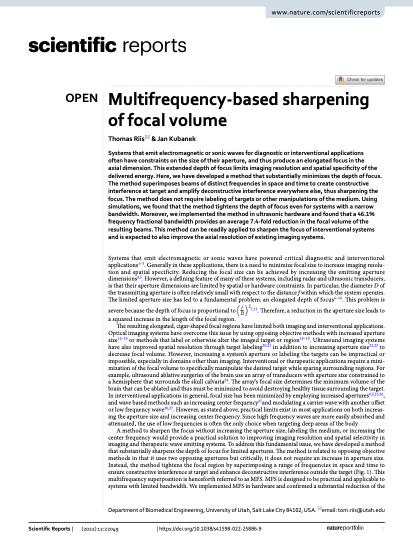 Article published in Scientific Reports
This articles provides an approach to shrink focal volume using frequency superposition.
December 20, 2022
Article published in Scientific Reports
This articles provides an approach to shrink focal volume using frequency superposition.
December 20, 2022
 Article published in iScience
This article provides a device that programmatically delivers focused ultrasonic waves into specified deep brain targets.
November 1, 2022
Article published in iScience
This article provides a device that programmatically delivers focused ultrasonic waves into specified deep brain targets.
November 1, 2022
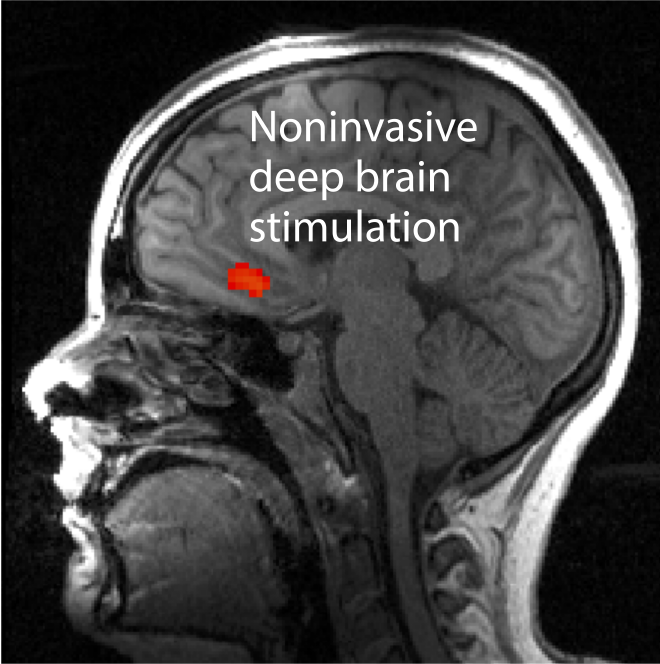 Treatments of depression
Together with Brian Mickey, we have initiated a clinical trial to use DIADEM to treat major depression.
October 13, 2022
Treatments of depression
Together with Brian Mickey, we have initiated a clinical trial to use DIADEM to treat major depression.
October 13, 2022
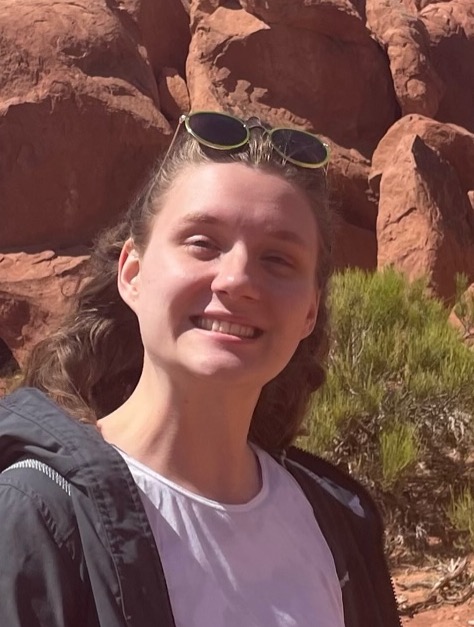 Gabrielle Bingener is selected for Summer Program for Undergraduate Research
Gabrielle will characterize the response of specific cell types to ultrasonic stimulation
April 30, 2022
Gabrielle Bingener is selected for Summer Program for Undergraduate Research
Gabrielle will characterize the response of specific cell types to ultrasonic stimulation
April 30, 2022
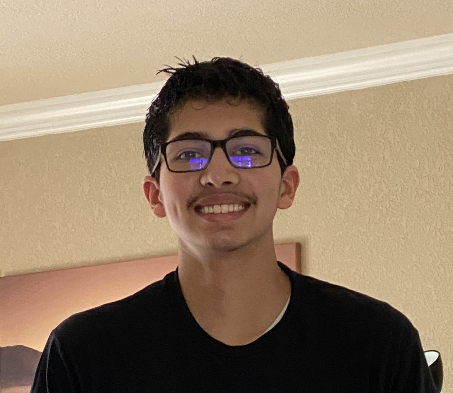 Aarav Parikh receives the Charles Steger Global Internship.
Aarav works on an approach that delivers drugs specifically at the focus of ultrasound.
April 20, 2022
Aarav Parikh receives the Charles Steger Global Internship.
Aarav works on an approach that delivers drugs specifically at the focus of ultrasound.
April 20, 2022
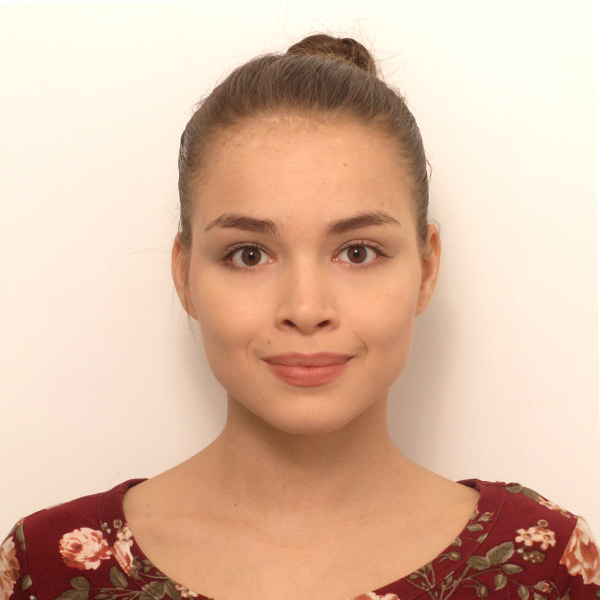 Anna Yarema receives the UROP fellowship
Anna works on an approach that releases drugs locally at the focus of noninvasive ultrasound. Congratulations, Anna!
April 13, 2022
Anna Yarema receives the UROP fellowship
Anna works on an approach that releases drugs locally at the focus of noninvasive ultrasound. Congratulations, Anna!
April 13, 2022
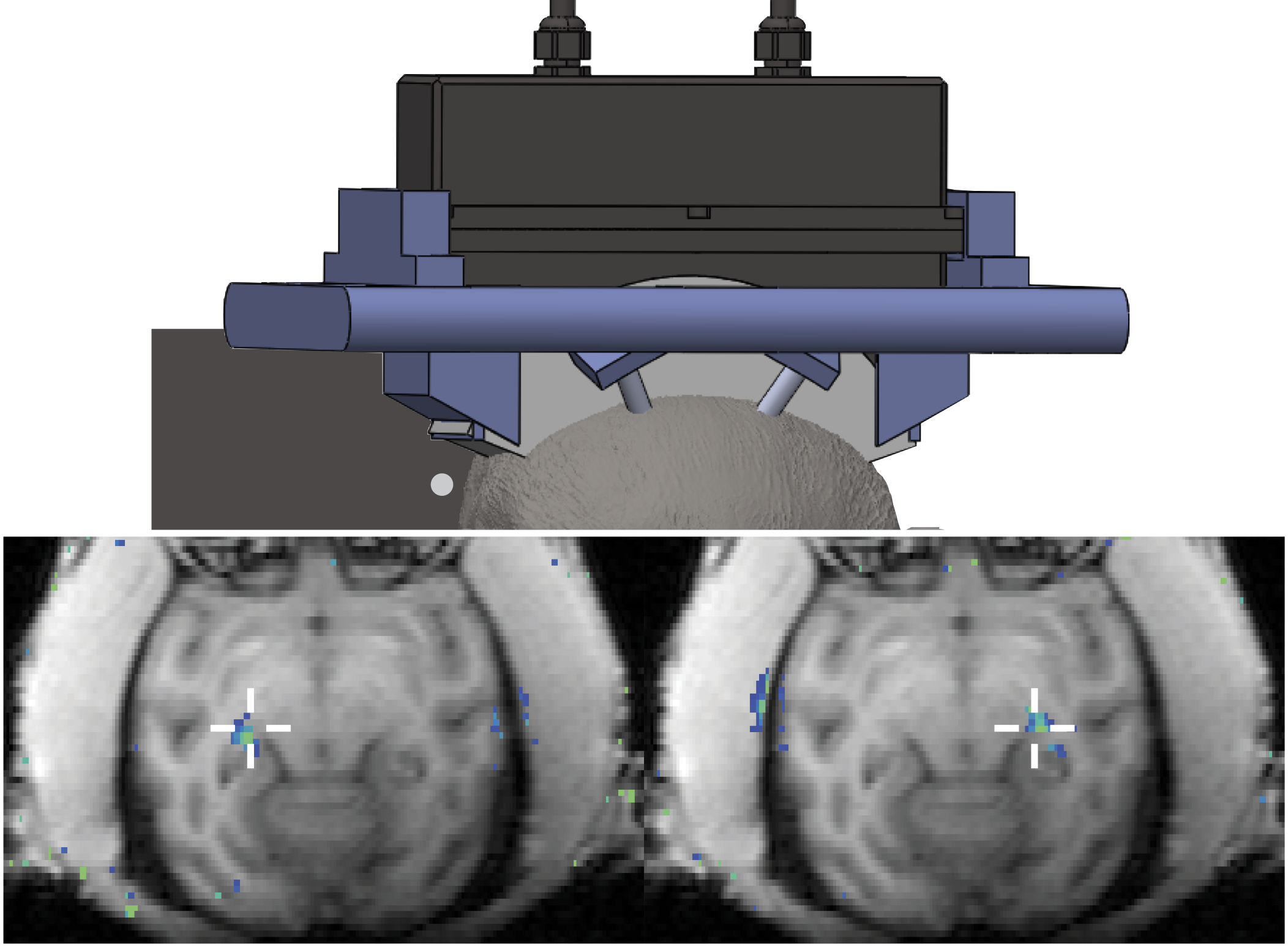 Platform for Remote, Multifocal Brain Interventions
Remus is an noninvasive, ultrasound-based system that manipulates specified deep brain circuits on command. This practical system enables researchers and clinicians to diagnose and treat specific deep brain noninvasively yet in a targeted manner, thus embodying the promise of personalized treatments of brain disorders. We now provide the hardware and software to assemble and use the system in the Tools section. The image link on the left shows how the system can be used to modulate deep brain circuits and behavior.
October 20, 2021
Platform for Remote, Multifocal Brain Interventions
Remus is an noninvasive, ultrasound-based system that manipulates specified deep brain circuits on command. This practical system enables researchers and clinicians to diagnose and treat specific deep brain noninvasively yet in a targeted manner, thus embodying the promise of personalized treatments of brain disorders. We now provide the hardware and software to assemble and use the system in the Tools section. The image link on the left shows how the system can be used to modulate deep brain circuits and behavior.
October 20, 2021
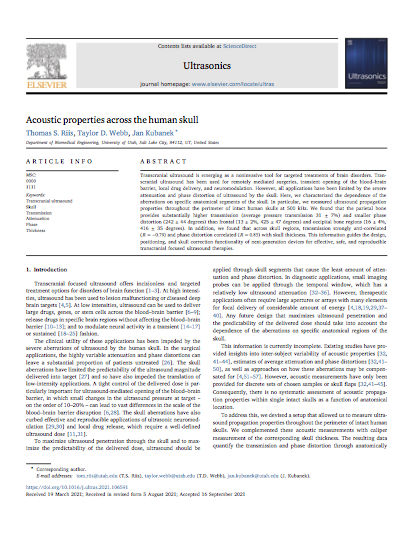 Article published in Ultrasonics
Tom's article shows the acoustic properties of human skulls as a function of specific anatomical locations. We used this information to build a practical device for ultrasonic interventions in the human brain.
October 15, 2021
Article published in Ultrasonics
Tom's article shows the acoustic properties of human skulls as a function of specific anatomical locations. We used this information to build a practical device for ultrasonic interventions in the human brain.
October 15, 2021
 Grant from the Focused Ultrasound Foundation
The lab received funding from the Focused Ultrasound Foundation to develop protocols for durable treatments of the neural circuits involved in anxiety disorders.
August 20, 2021
Grant from the Focused Ultrasound Foundation
The lab received funding from the Focused Ultrasound Foundation to develop protocols for durable treatments of the neural circuits involved in anxiety disorders.
August 20, 2021
 Grant from the National Institute of Neurological Disorders and Stroke
The lab will participate in a project that develops human brain organoids as a new, personalized way for understanding and treating neurological disorders.
August 2, 2021
Grant from the National Institute of Neurological Disorders and Stroke
The lab will participate in a project that develops human brain organoids as a new, personalized way for understanding and treating neurological disorders.
August 2, 2021
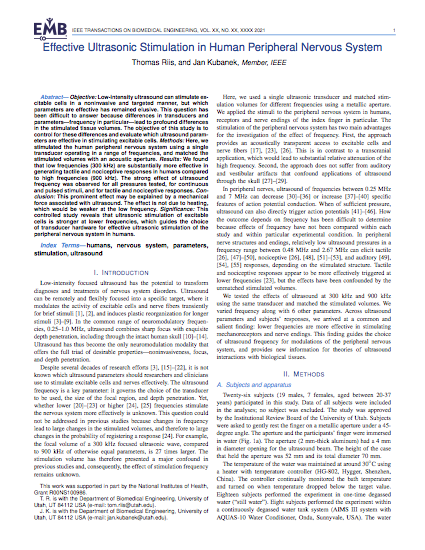 Article published in IEEE Transactions on Biomedical Engineering
Tom's article shows that the human peripheral nervous system is more effectively stimulated with ultrasound at low frequencies. This result also bolsters the notion of mechanical effects of ultrasound on excitable cells.
Congratulations, Tom!
May 27, 2021
Article published in IEEE Transactions on Biomedical Engineering
Tom's article shows that the human peripheral nervous system is more effectively stimulated with ultrasound at low frequencies. This result also bolsters the notion of mechanical effects of ultrasound on excitable cells.
Congratulations, Tom!
May 27, 2021
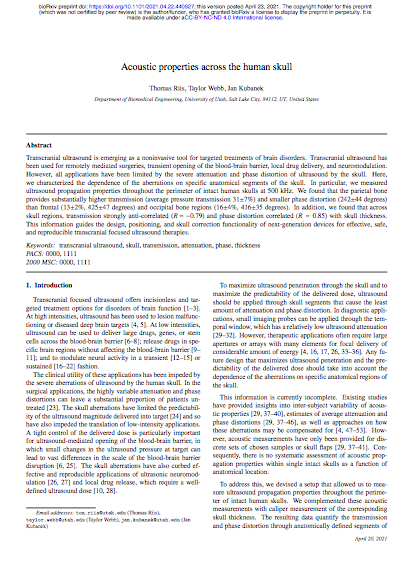 Acoustic properties across the human skull
This information led to the development of a new device, "Diadem", that delivers focused ultrasound into specified deep brain circuits of humans at a controlled dose. This controlled approach safely delivers into the desired circuits much higher ultrasound intensities than previously possible, thus increasing the efficacy and reproducibility of ultrasound-based interventions.
April 15, 2021
Acoustic properties across the human skull
This information led to the development of a new device, "Diadem", that delivers focused ultrasound into specified deep brain circuits of humans at a controlled dose. This controlled approach safely delivers into the desired circuits much higher ultrasound intensities than previously possible, thus increasing the efficacy and reproducibility of ultrasound-based interventions.
April 15, 2021
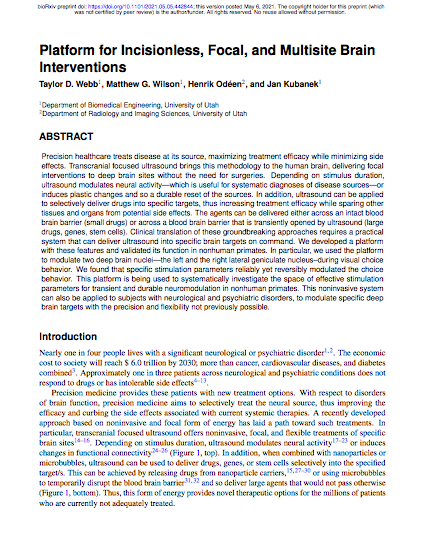 Platform for incisionless, multifocal brain stimulation
This new system delivers transcranial focused ultrasound into specified deep brain targets remotely, on command.
This paper demonstrates its application in modulating behavior in awake behaving non-human primates.
March 11, 2021
Platform for incisionless, multifocal brain stimulation
This new system delivers transcranial focused ultrasound into specified deep brain targets remotely, on command.
This paper demonstrates its application in modulating behavior in awake behaving non-human primates.
March 11, 2021
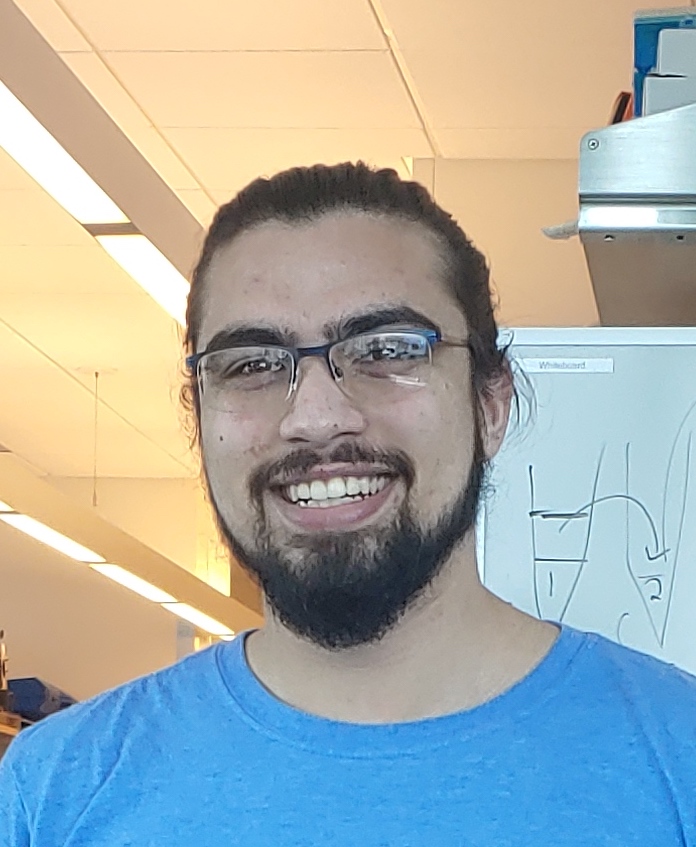 Rahul Cheeniyil joins the lab
Rahul will develop an entirely new approach to modulate neural activity noninvasively and in a targeted way. Welcome aboard, Rahul!
January 10, 2021
Rahul Cheeniyil joins the lab
Rahul will develop an entirely new approach to modulate neural activity noninvasively and in a targeted way. Welcome aboard, Rahul!
January 10, 2021
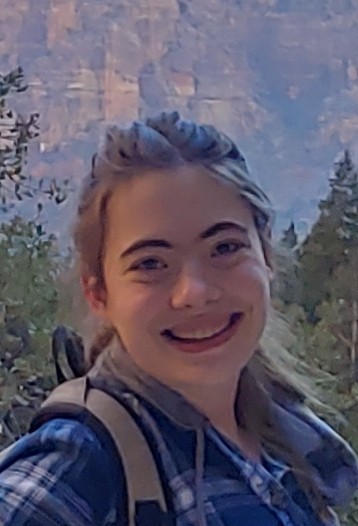 Sarah Haslam joins the lab
Sarah will optimize current local drug delivery approaches. Welcome aboard, Sarah!
January 6, 2021
Sarah Haslam joins the lab
Sarah will optimize current local drug delivery approaches. Welcome aboard, Sarah!
January 6, 2021
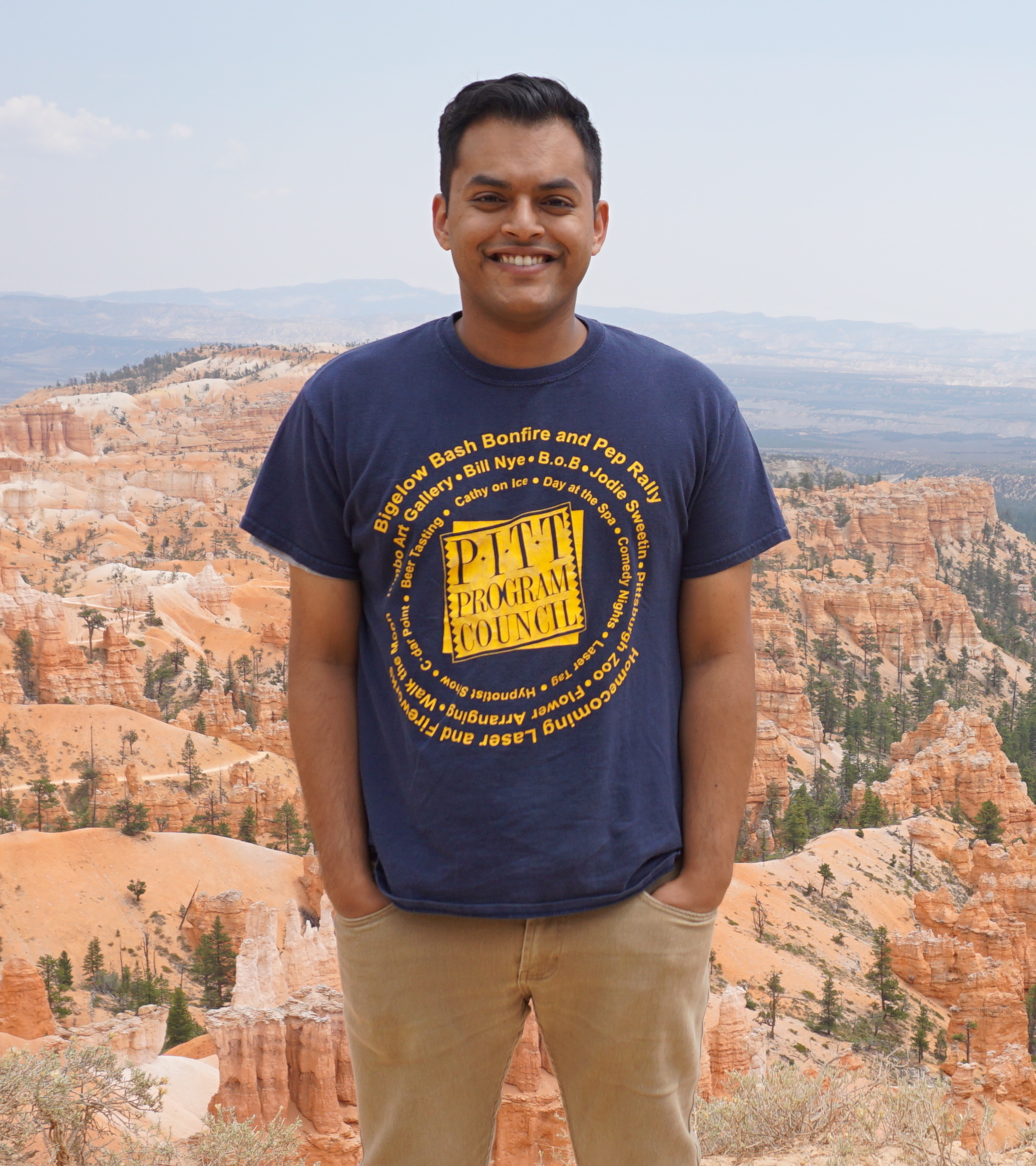 Arjun Acharya receives his Masters degree
Arjun completed the required work to receive his Masters within the Neural Engineering track. Congratulations, Arjun!
December 20, 2020
Arjun Acharya receives his Masters degree
Arjun completed the required work to receive his Masters within the Neural Engineering track. Congratulations, Arjun!
December 20, 2020
 Article accepted in Science Advances
This study shows that ultrasound, applied noninvasively to specific brain regions, can influence choice behavior of primates.
March 9, 2020
Article accepted in Science Advances
This study shows that ultrasound, applied noninvasively to specific brain regions, can influence choice behavior of primates.
March 9, 2020
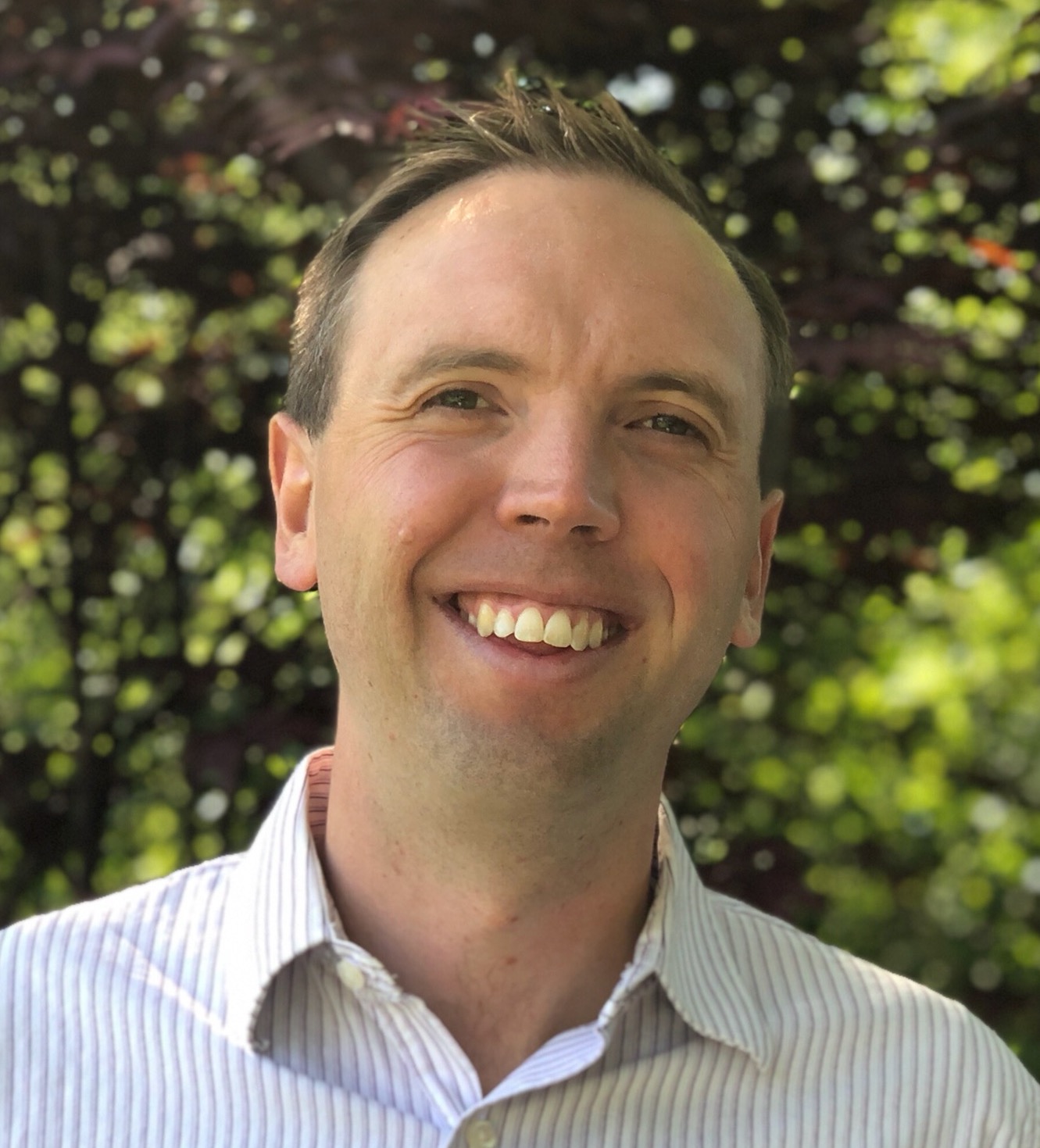 Taylor Webb receives the NIH Brain Initiative F32 award
Taylor performs noninvasive, targeted deep brain therapies in awake behaving primates to treat a variety of mental and neurological disorders and to learn about basic brain function.
February 22, 2020
Taylor Webb receives the NIH Brain Initiative F32 award
Taylor performs noninvasive, targeted deep brain therapies in awake behaving primates to treat a variety of mental and neurological disorders and to learn about basic brain function.
February 22, 2020
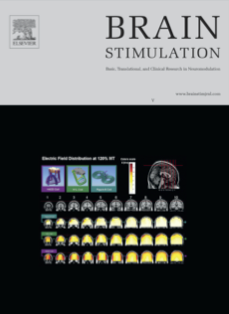 Article published in Brain Stimulation
We conclude that repeated ultrasonic brain stimulation in large animals is safe.
February 21, 2020
Article published in Brain Stimulation
We conclude that repeated ultrasonic brain stimulation in large animals is safe.
February 21, 2020
 Margolis Foundation seed grant
The Ben B. and Iris M. Margolis Foundation generously supported our development of brain stimulation hardware.
October 31, 2019
Margolis Foundation seed grant
The Ben B. and Iris M. Margolis Foundation generously supported our development of brain stimulation hardware.
October 31, 2019
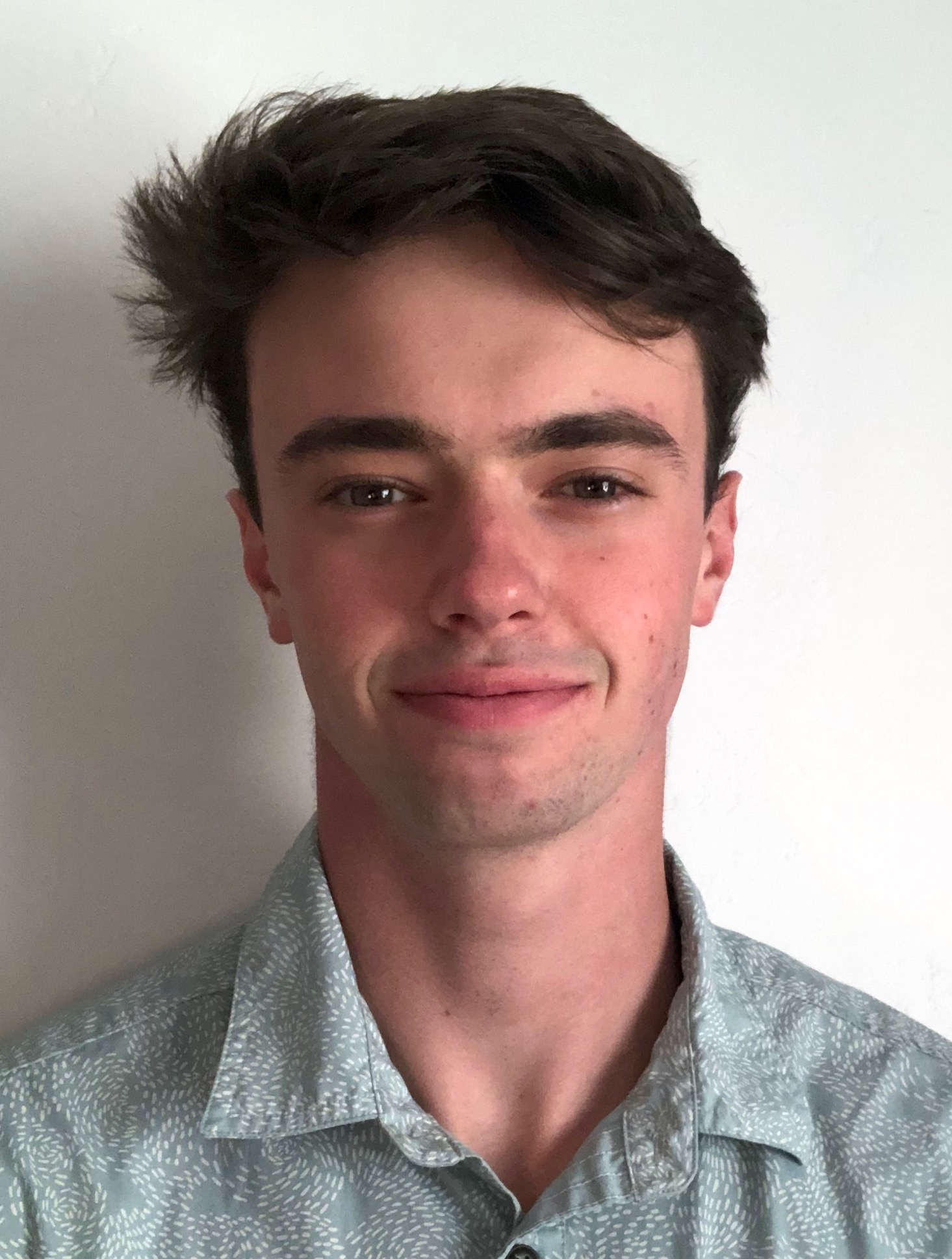 Alex Farley receives Capstone Project award
Alex's project receives Capstone funding.
Congratulations, Alex!
September 11, 2019
Alex Farley receives Capstone Project award
Alex's project receives Capstone funding.
Congratulations, Alex!
September 11, 2019
 NIH R00 grant
The lab received funding from the National Institute of Neurological Disorders and Stroke to develop methods for precise and noninvasive modulation of the nervous system.
August 20, 2019
NIH R00 grant
The lab received funding from the National Institute of Neurological Disorders and Stroke to develop methods for precise and noninvasive modulation of the nervous system.
August 20, 2019
 Alex Farley receives the UROP fellowship
Alex investigates the effects of ultrasonic waves on the activity of human neurons. Congratulations, Alex!
July 30, 2019
Alex Farley receives the UROP fellowship
Alex investigates the effects of ultrasonic waves on the activity of human neurons. Congratulations, Alex!
July 30, 2019
 Charles Steger Global Internship Program in Focused Ultrasound
Our high school students of the Navajo tribe, Karla Tapia and Lelah Alhemrani, have been awarded with the Charles Steger Global Internship of the Focused Ultrasound Foundation. Congratulations, Karla and Lelah!
May 1, 2019
Charles Steger Global Internship Program in Focused Ultrasound
Our high school students of the Navajo tribe, Karla Tapia and Lelah Alhemrani, have been awarded with the Charles Steger Global Internship of the Focused Ultrasound Foundation. Congratulations, Karla and Lelah!
May 1, 2019
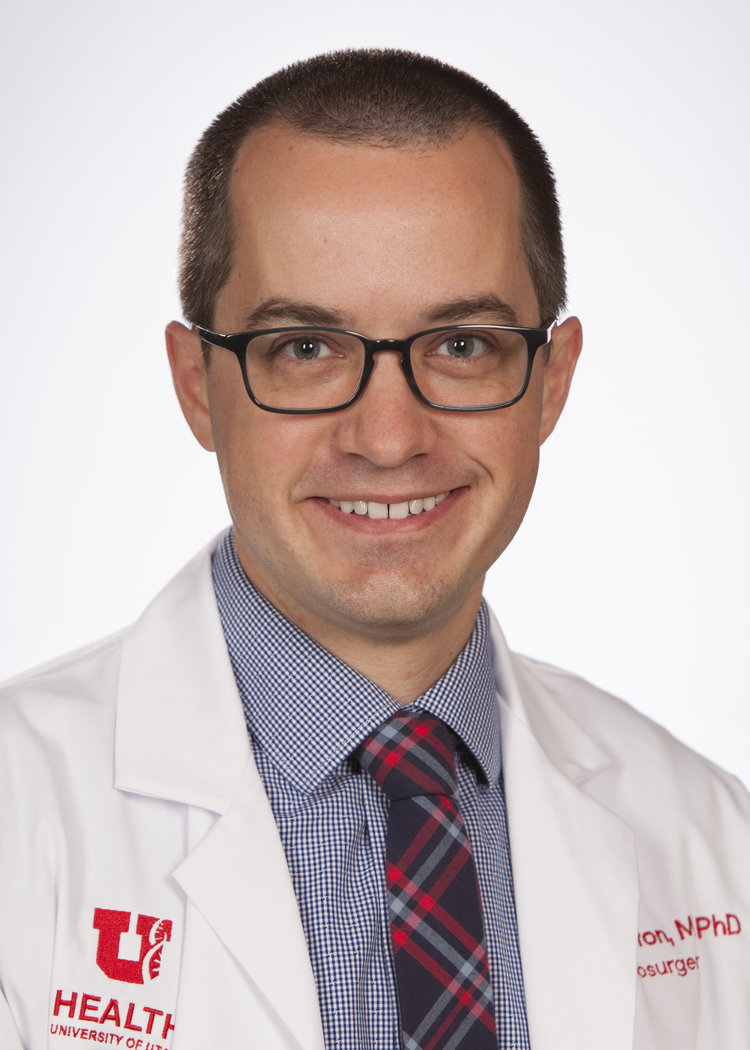 Collaboration with the Rolston lab
We investigate the effects of sonic stimulation protocols on neural activity in humans.
April 2, 2019
Collaboration with the Rolston lab
We investigate the effects of sonic stimulation protocols on neural activity in humans.
April 2, 2019
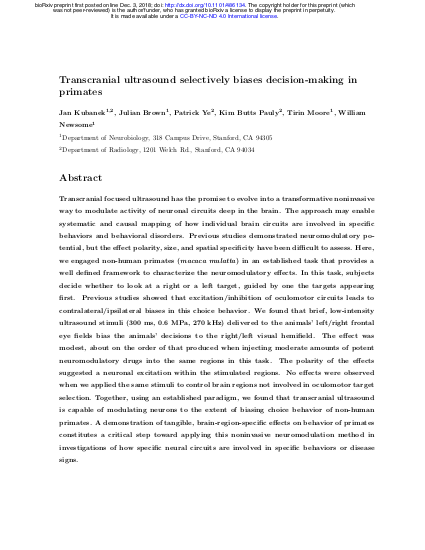 Preprint of sonic neurostimulation in non-human primates
We found that transcranial ultrasound is capable of modulating neurons to the extent of biasing choice behavior of non-human primates. A demonstration of tangible, brain-region-specific effects on behavior of primates constitutes a critical step toward applying this noninvasive neuromodulation method in investigations of how specific neural circuits are involved in specific behaviors or disease signs.
March 25, 2019
Preprint of sonic neurostimulation in non-human primates
We found that transcranial ultrasound is capable of modulating neurons to the extent of biasing choice behavior of non-human primates. A demonstration of tangible, brain-region-specific effects on behavior of primates constitutes a critical step toward applying this noninvasive neuromodulation method in investigations of how specific neural circuits are involved in specific behaviors or disease signs.
March 25, 2019
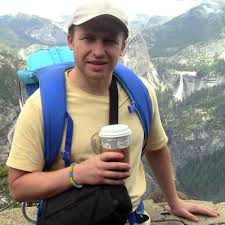 Collaboration with the Shcheglovitov lab
We investigate the effects of sonic stimulation protocols on the activity of human neurons.
November 11, 2018
Collaboration with the Shcheglovitov lab
We investigate the effects of sonic stimulation protocols on the activity of human neurons.
November 11, 2018
 Collaboration with the Vinberg lab
We investigate the effects of sonic stimulation protocols on the activity of retinal cells.
October 12, 2018
Collaboration with the Vinberg lab
We investigate the effects of sonic stimulation protocols on the activity of retinal cells.
October 12, 2018
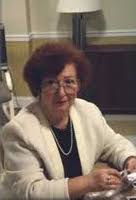 Collaboration with Natalya Rapoport
We build on the work of Natalya Rapoport to release drugs from nanoparticle carriers focally using ultrasound.
September 3, 2018
Collaboration with Natalya Rapoport
We build on the work of Natalya Rapoport to release drugs from nanoparticle carriers focally using ultrasound.
September 3, 2018
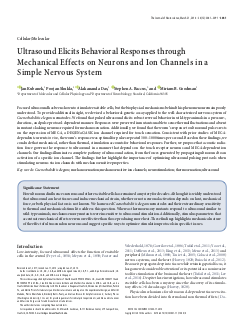 Research paper published in the Journal of Neuroscience
A remote control of cellular excitability in specific regions deep in tissue would constitute a powerful diagnostic and therapeutic tool. Ultrasound has demonstrated this promise, yet how ultrasound stimulates excitable cells has remained elusive. This study shows that ultrasound acts on tissues as a mechanical stimulus and so opens membrane ion channels. This mechanistic insight informs the design of protocols that maximize the stimulatory effects.
February 28, 2018
Research paper published in the Journal of Neuroscience
A remote control of cellular excitability in specific regions deep in tissue would constitute a powerful diagnostic and therapeutic tool. Ultrasound has demonstrated this promise, yet how ultrasound stimulates excitable cells has remained elusive. This study shows that ultrasound acts on tissues as a mechanical stimulus and so opens membrane ion channels. This mechanistic insight informs the design of protocols that maximize the stimulatory effects.
February 28, 2018
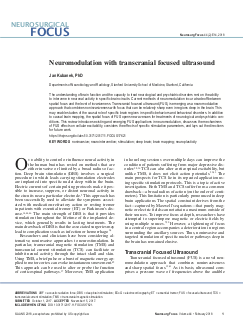 Review article published in Neurosurgical Focus
The understanding of brain function and the capacity to treat neurological and psychiatric disorders rest on the ability
to intervene in neuronal activity in specific brain circuits. Current methods of neuromodulation incur a tradeoff between spatial focus and the level of invasiveness. Transcranial focused ultrasound (FUS) is emerging as a neuromodulation approach that combines noninvasiveness with focus that can be relatively sharp even in regions deep in the brain. This may enable studies of the causal role of specific brain regions in specific behaviors and behavioral disorders. In addition to causal brain mapping, the spatial focus of FUS opens new avenues for treatments of neurological and psychiatric conditions. This review introduces existing and emerging FUS applications in neuromodulation, discusses the mechanisms of FUS effects on cellular excitability, considers the effects of specific stimulation parameters, and lays out the directions for future work.
December 2, 2017
Review article published in Neurosurgical Focus
The understanding of brain function and the capacity to treat neurological and psychiatric disorders rest on the ability
to intervene in neuronal activity in specific brain circuits. Current methods of neuromodulation incur a tradeoff between spatial focus and the level of invasiveness. Transcranial focused ultrasound (FUS) is emerging as a neuromodulation approach that combines noninvasiveness with focus that can be relatively sharp even in regions deep in the brain. This may enable studies of the causal role of specific brain regions in specific behaviors and behavioral disorders. In addition to causal brain mapping, the spatial focus of FUS opens new avenues for treatments of neurological and psychiatric conditions. This review introduces existing and emerging FUS applications in neuromodulation, discusses the mechanisms of FUS effects on cellular excitability, considers the effects of specific stimulation parameters, and lays out the directions for future work.
December 2, 2017
 May 2, 2025
May 2, 2025
 March 14, 2025
March 14, 2025
 June 14, 2024
June 14, 2024
 January 10, 2024
January 10, 2024
 January 5, 2024
January 5, 2024
 December 5, 2023
December 5, 2023
 October 1, 2023
October 1, 2023
 August 12, 2023
August 12, 2023
 July 20, 2023
July 20, 2023
 May 30, 2023
May 30, 2023
 May 20, 2023
May 20, 2023
 February 17, 2023
February 17, 2023
 April 30, 2022
April 30, 2022
 April 20, 2022
April 20, 2022
 April 13, 2022
April 13, 2022
 August 20, 2021
August 20, 2021
 August 2, 2021
August 2, 2021
 January 10, 2021
January 10, 2021
 January 6, 2021
January 6, 2021
 December 20, 2020
December 20, 2020
 February 22, 2020
February 22, 2020
 September 11, 2019
September 11, 2019
 August 20, 2019
August 20, 2019
 July 30, 2019
July 30, 2019
 May 1, 2019
May 1, 2019
 April 2, 2019
April 2, 2019
 November 11, 2018
November 11, 2018
 October 12, 2018
October 12, 2018
 September 3, 2018
September 3, 2018




























